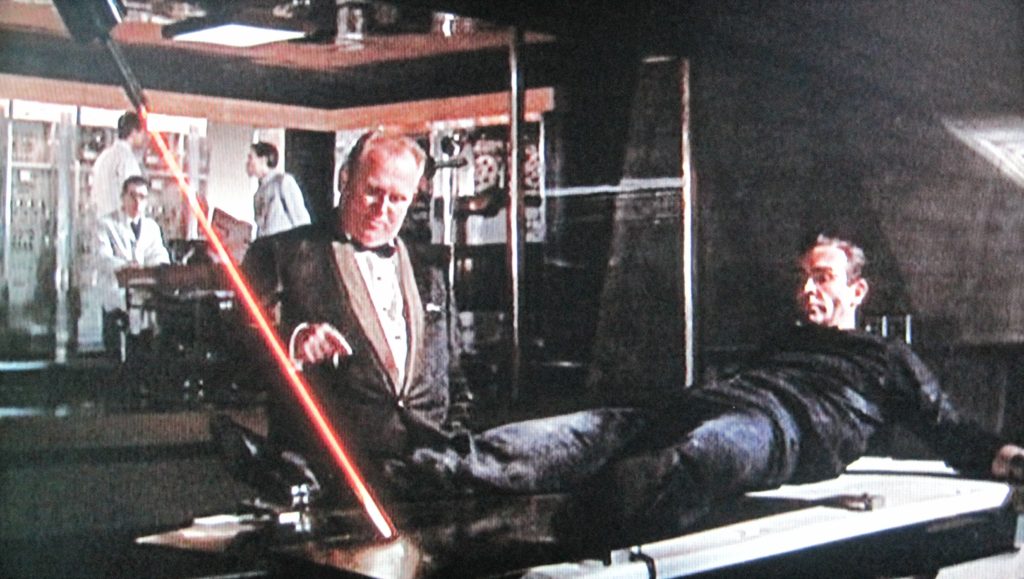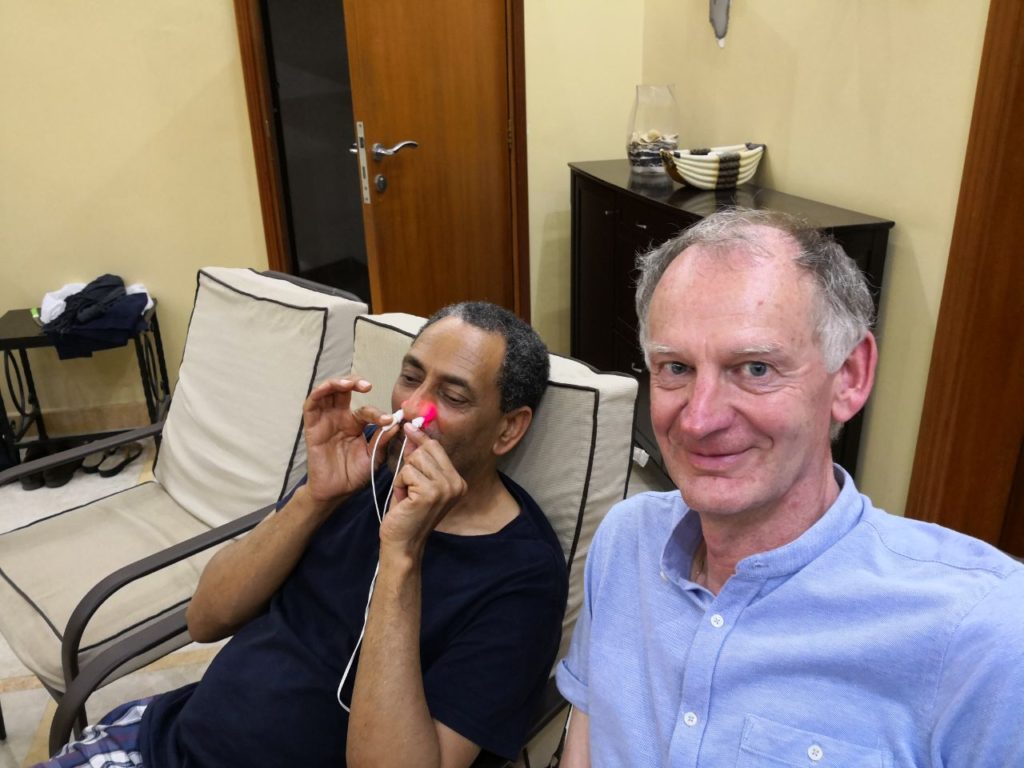One of my favorite movies, when I was a lot younger, was “Goldfinger” after the book by Ian Fleming, especially the scene where the crook Goldfinger is preparing to kill my hero by cutting him into two with a laser beam. That miraculous red beam that not only could cut my action hero in two parts, but also cuts through concrete walls and steel doors. Guess what I asked for a next birthday….

Lasers have become quite common: in CD players, as laser pointers, or in laser shows for entertainment. These, of course, are low level lasers that won’t cut through anything. But due to the special qualities of the laser light, it can be used for treatment of many physical problems and for performance enhancement.

Low level laser light can change the metabolism of the underlying cells and tissues. Since one of the characteristics of laser is that it keeps its quality over distance (try to point at a screen with a torchlight of the same power) it can therefore penetrate deeper than the just the surface of the skin. So it is used in low level laser therapy of LLLT or also known as photobiomodulation, the modulation of biological structures by (laser)light.
The effect of LLLT has a wide range of applications. We use LLLT for the brain by putting the laser electrodes in the ears or the nose, dependent on the indication. (1, 2, 3) We already know that light has a distinct effect on the brain, think of the effects of sunlight, blue light from phone or tablet screens on melatonin secretion. (4) The red light of the laser can be directly targeted through the nose or ears at the pineal gland and hypothalamus, and can then have an effect on depression, tinnitus, migraine, or insomnia and many other brain-related issues (5, 6)

Peripherally LLLT can be used by putting the electrode(-s) on the skin so it can reach the underlying tissues: bone, fascia, or tendon (7, 8, 9,10). But LLLT can also be applied on acupuncture points or meridians (11)
For a whole range of sports injuries LLLT is also a good application to try. (12) But for athletes, LLLT might also have a direct ergogenic effect as well, on muscle performance, fatigue, and recovery which might be interesting. (13, 14, 15, 16)
In short: LLLT is a gentle, easy, cheap and safe application with many possible indications that might affect body and brain in a positive way. As a coach it has helped me when my athletes had to deal with small problems that might affect their performance negatively. Maybe a marginal gain, but at least a gain, not a marginal loss.
And if you might run into an affordable “Goldfinger-laser-system” I am still interested….
1. Hennessy,M; Hamblin, M.R: Photobiomodulation and the brain: a new paradigm; Opt. 2017 January ; 19(1): 013003-
2. Rochas, J.C; Gonzalez-Lima, F: Low-level light therapy of the eye and brain; Eye and Brain 2011:3 pg. 49–67
3. Gonzalez-Lima, F; Barrett, D.W: Augmentation of cognitive brain functions with transcranial lasers; Frontiers in Systems Neuroscience; March 2014, Volume, Article 36.
4. Sun, L; Peräkylä,J, et al.: Human Brain Reacts to Transcranial Extraocular Light; PLoS ONE, 2016, 11(2): e0149525.
5. Cassano, P; Petrie, S.R, et al.: Review of transcranial photobiomodulation for major depressive disorder: targeting brain metabolism, inflammation, oxidative stress, and neurogenesis; Neurophotonics 3(3), 031404 (Jul–Sep 2016)
6. Drviš, P; Trotić, R, et al.: Low level laser therapy (LLLT) for chronic tinnitus; Laser in Medicine, Vol I, Issue 2, January 2013.
7. Manescu, A; et al: On Long Term Effects of Low Power Laser Therapy on Bone Repair; Int J Radiol Imaging Technol 2016, 2:010, Vol.2, Issue 1.
8. Ebrahimi, T, et al.: The Influence of Low-Intensity Laser Therapy on Bone Healing; Journal of Dentistry, Tehran University of Medical Sciences, 2012; Vol. 9, No. 4,pg. 238-248.
9. Momenzadeh, S; Akhyani, V; Razaghi, Z; Ebadifar, A; Abbasi, M: Evaluation of the effects of intravenousand percutaneous low level laser therapy in the management of shoulder myofascial pain syndrome. J Lasers Med Sci. 2016;7(1):16-20.
10. Tumilty, S; Munn, J, et al: Low Level Laser Treatment of Tendinopathy: a systematic review with Meta-analysis; Photomedicine and Laser Surgery, Volume 28, Number 1, 2010, pg. 3-16.
11. Acosta-Olivo , C, et al: Laser Treatment on Acupuncture Points Improves Pain and Wrist Functionality in Patients Undergoing Rehabilitation Therapy after Wrist Bone Fracture. A Randomized, Controlled, Blinded Study; Int. J. Acupuncture and Electro-Therapeutics Res. Vol. 42, pp. 11-25, 2017.
12. Morimoto, Y, et al.: Low level laser therapy for sports injuries; Lase Therapy, 22(1), 2013, pg.17-20.
13. Leal Junior, E.C, et al.: Effect of 655-nm low-level laser therapy on exercise-induced skeletal muscle fatigue in humans; Photomed Laser Surg. 2008 Oct;26(5), pg. 419-424.
14. Ferraresi, C; Hamblin, M.R: Low-level laser (light) therapy (LLLT) on muscle tissue: performance, fatigue and repair; Photon Lasers Med 2012, 1(4), pg.267–286.
15. Tulppo, M.P. et al.: Effects of bright light treatment on psychomotor speed in athletes; Frontiers in Physiology, Exercise Physiology, May 2014, Volume5, Article 184
16. De Marchi, T; Leal Junior E.C, et al.: Low-level laser therapy (LLLT) in human progressive-intensity running: effects on exercise performance, skeletal muscle status, and oxidative stress. Lasers Med Sci 27 (2012), pg.231–236.
17. Salehpour1, F; Mahmoudi, F: Brain Photobiomodulation Therapy: a Narrative Review; Molecular Neurobiology; https://doi.org/10.1007/s12035-017-0852-4
